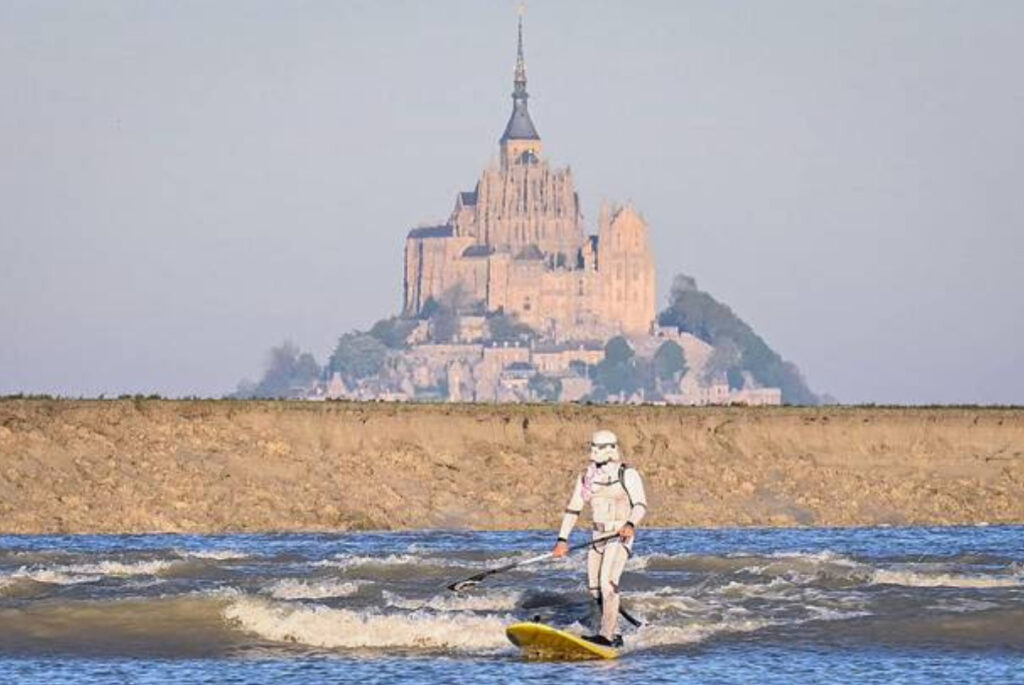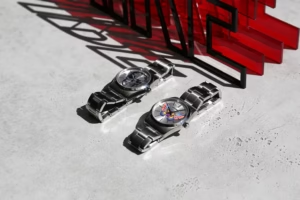In the ethereal hours of early May, as tides slip across the haunting flats of Mont Saint-Michel Bay and the wind carries the salty memory of conquest, pilgrimage, and myth, a lone figure appears: a Stormtrooper—white-armored, paddle in hand, mounted atop a surfboard. This isn’t a mirage from a galaxy far, far away. It’s real. A scene both cinematic and comic, solemn and surreal. A man dressed in full Imperial garb, gliding across the mirror of the bay’s tidal waters beneath the monastic silhouette of France’s most storied tidal island. On this day, May 4th—recognized globally as Star Wars Day—the worlds of surf culture, performance art, and science fiction collided in a tableau that felt both timeless and utterly of the moment.
The annual refrain, “May the Fourth be with you,” which began as a playful pun, has over time become a cultural ritual of impressive scale. But what happens when that ritual is projected not onto convention halls or themed Instagram posts, but into the physical landscape of heritage, nature, and athleticism? What emerges when one uses the language of cinematic fandom to author a new kind of pilgrimage—one written not with sacred relics, but with plastic armor and a carbon-fiber board?
This editorial delves into the image, the gesture, and the geography of the Stormtrooper paddler of Mont Saint-Michel—a performance both accidental and intentional, deeply absurd and deeply reverent. It is a story about play, but also about the power of symbol in contemporary myth-making. Surfing here becomes more than sport. It becomes invocation.
The Architecture of the Backdrop: Mont Saint-Michel as Cosmic Cathedral
To understand the impact of the scene, one must first consider its stage. Mont Saint-Michel is not simply a backdrop—it is a player in the performance. This rocky island commune in Normandy has, for over a millennium, stood as a symbol of transcendence. Its abbey rises like a gothic beacon from the tidal plains, a marvel of vertical engineering and spiritual ambition. Historically, pilgrims crossed the dangerous bay at low tide, risking quicksand and currents to reach the monastery—a literal and metaphysical journey through liminality.
In this context, the lone paddler in Star Wars cosplay becomes something of a secular pilgrim himself. Instead of walking barefoot over shifting sands toward divine silence, he skims the waters on a paddleboard, clad in the uniform of pop-culture authoritarianism, headed perhaps not toward revelation but toward viral immortality. Yet there’s resonance here—something unexpected. The Stormtrooper’s anonymous, expressionless face, meant in the films to signify faceless conformity and systemic obedience, is transformed into an everyman mask. A conduit not of evil, but of shared cultural memory.
As the tide rolls beneath him, the water carries centuries of symbolism. Pilgrimage meets performance. The abbey looms not in judgment, but in quiet witness. A Force—if not the Force—is undeniably present.
The Stormtrooper as Mythic Mask
The decision to don a Stormtrooper costume is not merely a joke or eccentricity. The mask itself is one of the most recognizable silhouettes in contemporary iconography—its sharp frown, dark visor, and helmeted dome evoke Orwellian fear, fascist regimentation, and dehumanized futurism. Yet over the decades, the Stormtrooper has drifted from its origin as foot soldier of galactic tyranny to something more elastic, more ambiguous. It has become a symbol worn as both parody and tribute.
When placed on a paddleboard and set against a medieval backdrop, the Stormtrooper takes on qualities that defy narrative. This isn’t a Sith raid or a rebel blockade; it’s not a scene from A New Hope or The Rise of Skywalker. It’s a completely new myth being authored in real time. In this light, the Stormtrooper is less a villain than a vessel—an abstracted human navigating the tides of meaning, just as he navigates the literal tides of Mont Saint-Michel.
There is also humor, and in humor, profundity. The absurdity of the image—white plastic armor bobbing atop brackish waters—is not merely for laughs. It underscores the slipperiness of identity in the meme age. It critiques our reliance on brand mythology even as it celebrates it. It is, at once, cosplay and cosmic satire.
Surfing as Spectacle, Paddleboarding as Liturgy
Surf culture, historically, has always held ritualistic qualities. To surf is to enter into dialogue with the ocean—a communion built on balance, flow, and surrender. Paddleboarding, though less dramatic than wave riding, is its own kind of ceremony: a slow, meditative traversal of liquid space. That a figure as culturally weighted as a Stormtrooper engages in such a practice is not merely novelty—it is invitation. To see this image is to feel its magnetism, to ask: What are the modern rituals by which we perform identity? How do we blend recreation and reverence?
In the photograph—often circulated online with captions like “Only in France” or “A Force Awakens in Normandy”—the water gleams like glass. The figure casts no real shadow, becoming a spectral trace, as if the paddleboard itself is hovering. He is not battling tides but moving with them, like a monk from some sci-fi brotherhood, practicing aquatic devotion.
That is perhaps what gives the scene such lingering resonance: its paradoxical stillness. The Stormtrooper is not conquering. He is not enforcing. He is, for once, free. Freed from cinematic constraint, freed from the Empire, freed even from audience expectations. He glides forward, not in service of narrative, but in defiance of it.
The Mythology of May 4th: From Franchise to Folk Ritual
“May the Fourth” is no longer the clever pun it once was. It has grown into a globally recognized celebration of Star Wars fandom—a decentralized holiday complete with merchandise releases, costume parades, film screenings, and themed menus at restaurants and bars. What began as internet wordplay has ossified into something resembling folk ritual: familiar, performative, collectively felt.
In this evolution, Star Wars has transcended its cinematic origins and entered the mythic. Like Greek or Norse tales before it, the saga now exists in a collective dreamspace. Characters become archetypes. Conflicts become allegories. And dates—arbitrary though they may be—become sacred.
So when a surfer dons Stormtrooper armor and floats across France’s most storied bay, he is not merely referencing a movie. He is participating in an act of mythopoeia: world-building through action. He takes the abstract and makes it actual. The myth lives not on screen, but in the water, under the open sky.
And in that gesture lies a radical proposition: that pop culture, when lived with sincerity and creative verve, can become something close to sacred. Not in a religious sense, perhaps, but in its ability to connect disparate people through shared symbols and repeated rites.
Satire and Sincerity in the Same Breath
It would be easy to dismiss this act as gimmick. A viral stunt, engineered for clicks. And yet, the sincerity radiates from it. The effort it takes to paddle across cold water in a plastic costume. The commitment to theatricality. The understanding of visual impact. This is not idle performance. It is, in its own way, a deeply committed gesture.
That duality—of joke and devotion—is what defines contemporary folklore. The best memes are often tragic and hilarious. The best art, self-aware and shameless. In that liminal zone between irony and earnestness lies the power of modern myth. The paddleboarding Stormtrooper is funny, yes. But he is also beautiful. He is also us.
He is a 21st-century knight-errant, armor shining not from battle but from seawater and sun. He is not marching in formation but carving his own path. He is a fan, an artist, a monk, a mime. He is ridiculous. He is sublime.
The Idea
As the waters of Mont Saint-Michel retreat once more, revealing vast mudflats and shimmering illusions, the image of the Stormtrooper recedes too—back into the digital ether, back into the collective scroll of our daily myth-making. But the impression remains. Like a footprint in wet sand, it lingers just long enough to be remembered, re-shared, re-enacted.
The performance, whether spontaneous or planned, is more than spectacle. It is parable. A parable of joy, absurdity, fandom, solitude, tide, and time. A parable that needs no words, just image and resonance.
In that gliding figure—imperial yet humble, faceless yet expressive—we glimpse a world where sacred geography and speculative fiction can hold hands. A world where tides and timelines collapse into one floating metaphor.
On May 4th, in a bay kissed by history and salt, a Stormtrooper did not fall in battle. He did not guard a corridor or chase a rebel. He paddled. He moved gently forward. And in doing so, he offered us something better than canon: a living myth, carried by water and whim.
May the Fourth be with him. And may we all ride our own strange tides.
No comments yet.








